Stop taking pictures and start drawing!
Some drawings look fresh and alive while others … don’t. What is their secret? Let’s look at cameras first.
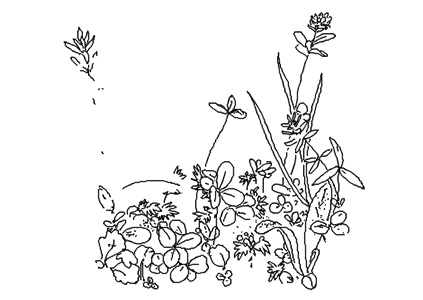
This is what happens when you take a photograph: The light rays of your environment project a picture on a photo sensor. This picture is then stored on a hard drive. It’s a recording process, straightforward and linear.
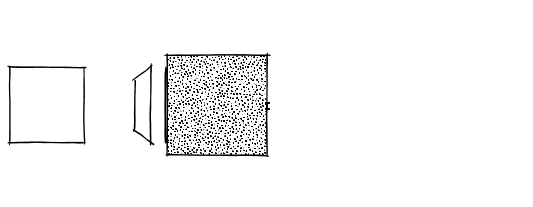
And this is not how you look at the world. Your mind is not a camera.
When you look at something, incredibly complex interactions occur between your eyes and your nervous system. You “recognise” what you see and form a very different kind of “picture”.
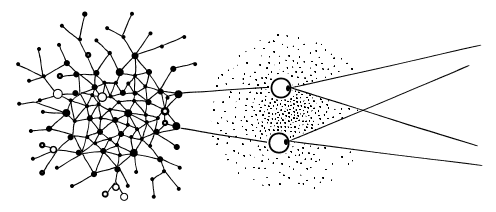
This “picture” is much more exciting, complex, and dynamic. It is part of the current state of your nervous system. Rather than a recording of the environment, it is a reaction of countless neurons — an interpretation.
Your memories, your mood, the physical state you are in — all this shapes your interpretation. No two people experience the same “picture”.
So when you draw something you are not simply recording the outside world. You are drawing your personal interpretation!
Now what does that mean for your drawings?
Don’t try to record like a camera!
Also, avoid drawing from photographs. If you draw from a photograph you draw your interpretation of a recorded picture, not your personal, rich interpretation of the real situation. You will create a “canned” drawing and people will taste the difference.
The secret to fresh drawings
Look at the world directly, understand what you see, and then come up with an idea how to draw your interpretation!
1. Look!
A big part of the drawing process is to “just” look and understand — without moving a finger (or a pen). What is special about the situation? Is there anything that resonates with your thoughts or feelings? Looking takes a lot of time and energy, for me it is the hardest part of the process.
When you found something interesting, the next step is to translate what you see onto a piece of paper.
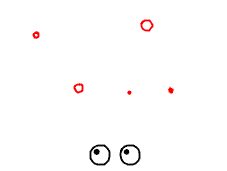
2. Tell us what you see!
Remember the last time you told somebody a story? I bet you didn’t indulge in every little detail (except your name is Marcel Proust), but instead you focussed on the parts that got you “to the point”.
It’s the same with drawing.
It is impossible to show everything in a drawing. So we have to focus on the things that matter and think of a way to show them. How do we arrange the elements on the paper? What colours should we use? Which sorts of lines help to make our point? We might approach those decisions in a rational or intuitive manner, just let’s not ignore them!
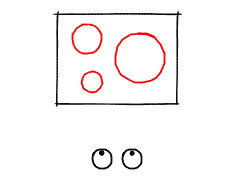
Here are 2 examples:
I made it a habit to draw little sketches of my everyday life. One of the rules I gave myself is to draw each picture in a single go. Usually I can stand still and concentrate for 1 to 3 hours. This time limit forces me to focus and think carefully about what I draw — and what I leave out.

The idea behind this grim drawing is to juxtapose a cheerful light drawing style (rhythmic variety of the cages) with a rather sombre composition (rigid symmetry). A small detail —a single bird outside the cages — increases the tension and leaves room for interpretation.
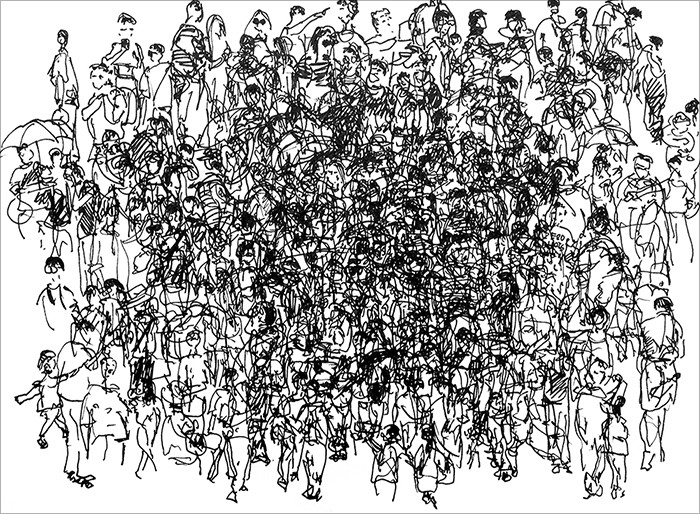
This drawing is more about the drawing process than the end result. To show my perception of a crowd I gradually moved from capturing beautiful individuals to filling the paper with a noisy mass. (Have a look at a video of the process here)
What about you?
What do you like about drawing? How is your drawing process? I would love to read your thoughts in the comment section below!
Before you go
If you enjoyed this article, then subscribe to my mailing list to receive more animated stories!
I really enjoy all of your insight, and that you share such knowledge with the rest of us . I have started to draw daily, and hope to get my thoughts onto paper as eloquently as you do (with A LOT more practice).
I’ve also started drawing pictures for my grandchildren to color, and since it seems to be very successful with them, I’ve begun to create a coloring book for them, comprised of different styles and subjects. It’s going to be so much fun, and I can’t wait to see the finished product, and the children’s reactions once it’s completed.
Thank you for all the helpful information and exercises that have really helped me to begin to draw. I’m not an artist, and didn’t get any training in it. But I’m enjoying it, and I’m finding peace and meditation through art, so thank you!
Nita
I teach High school art and often struggle with explaining the importance of really looking. You have a wonderful way of articulating the core concepts of seeing the world around us and finding our own voices within it. I came here after seeing your TED talk – which I am sharing with my students. Keep sharing your insight with us! Now more than ever it is key.
Brilliant! Super! Wirklich! Ich habe in Deutschland viele Jahren gelebt und seit 5 Jahren bin zurück nach Amerika umgezogen. Jetzt bin ich Lehrerin – Kunst, für High School – public school system. Was Sie hier gebaut, entwickelt habe ist wirklich Super! Und wie Steve Haske oben kommentiert hat – “Keep sharing your insight with us! Now more than ever it is key.
Mit freundlichen Grüßen,
Emily Phillips
Merhabalar ben Türkiyeden bir görsel sanatlar öğretmeniyim. Sizin yakından takip ediyorum.Bir öğretmen olarak sanatın gücüne inanıyorum.Yaptığım çalışmalar deneysel oluyor.Ve bu deneyimler sonucunda öğrenmenin hazzına ulaşıyorum. Dolayısıyla paylaşımlarınız bana yeni kapılar açıyor.Teşekkür ederim.
Drawing is the basis of my art. It’s not valued enough in the school curriculum.
Thank you for sharing your knowledge and insights of the drawing process. I am trying to do a drawing each day. I find it a rest for my mind and I love to see the result.
Thank you again